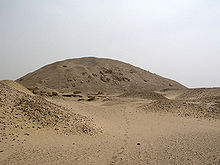| Pyramid of Senusret I | |
|---|---|
 | |
| Senusret I | |
| Coordinates | 29°33′36.04″N 31°13′15.40″E / 29.5600111°N 31.2209444°E |
| Ancient name | |
| Constructed | Twelfth Dynasty |
| Height | 61.25 m (201.0 ft; 116.89 cu)[2] |
| Base | 105.2 m (345 ft; 200.8 cu)[3] |
| Volume | 225,093 m3 (294,411 cu yd)[2] |
| Slope | 49°23′55″[2] |




The pyramid of Senusret I is an Egyptian pyramid built to be the burial place of the Pharaoh Senusret I. The pyramid was built during the Twelfth Dynasty of Egypt at el-Lisht, near the pyramid of his father, Amenemhat I. Its ancient name was Senusret Petei Tawi (Senusret beholds the two lands).[4]
The pyramid was 105 meters on each side with a height of 61.25 meters; the slope of the four faces was 49° 24'. The pyramid used a method of construction never before seen in an Egyptian pyramid; four stone walls radiated from the center built of rough-hewn blocks that decreased in size the higher their placement. The eight sections formed by these walls were then subdivided by three more walls, splitting the pyramid into 32 different units which were then filled with slabs of stone as well as debris. An exoskeleton of fine limestone then covered the structure.[4] This new method of construction was not particularly efficient, however, and the completed pyramid suffered from stability problems. Unusually, clear evidence for the ramps used to construct the pyramid also remain.
- ^ Verner 2001, p. 399.
- ^ a b c Lehner 2008, p. 17.
- ^ Verner 2001, p. 465.
- ^ a b Lehner, M. (1997). The Complete Pyramids. London:Thames and Hudson Ltd. ISBN 0-500-05084-8